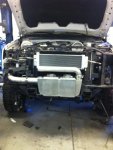Properly designing an efficient system can get really complicated really quickly. There are quite a few things you need to know in order to size your system. If you did know how much heat you were attempting to remove it would make it much easier. Without knowing that, you basically have to rely on assumptions and rough estimates.
For laughs, you could calculate the heat induced purely by the compression of air by your turbo (assuming an adiabatic process because we don't know how much heat is transferring through your turbo). This will give you a very rough, first-step approximation for the approximate size of components you will need.
You can rearrange the ideal gas law to output a temperature, which can later be plugged into the heat transfer equation Q=hA(T1-T2) in order to determine your heat added (Q) in Watts. Of course, you need to calculate your heat transfer coefficient, h, which is complicated when dealing with flow through pipes and a heat exchanger. But, hey, we're making assumptions here anyway, right?
Rearranging the ideal gas law PV=nRT to solve for temperature gives us (PV)/(nR) = T. Since you need to calculate T1 (pre-turbo) and T2 (post-turbo) you get two equations. It is important to note that n is the amount of air in moles and R is the ideal gas constant. The amount of air

remains constant after passing through the turbo. R is constant by definition.
Equation 1
(P1V1)/(nR) = T1
where V1 is the volume of air before being compressed and P1 is absolute atmospheric pressure.
Equation 2
(P2V2)/(nR) = T2
where V2 is the volume of air after being compressed and P2 is your absolute boost pressure
Solving for deltaT = (T1-T2) gives us deltaT = (P1V1)/(nR) - (P2V2)/(nR). This can be plugged in to the heat transfer equation to calculate for the amount of heat introduced to the air by compression.
Rewriting the heat transfer equation gives you Q = hA[(P1V1)/(nR) - (P2V2)/(nR)]. Here A is the surface area that the fluid is in contact with.
Solving for Q will give you a very rough estimate of the adiabatic heat introduced by compression. This Q is the same amount of energy you ideally want to remove using your air-to-water intercooler, therefore it is the same amount of heat you need to remove from your intercooler's radiator.
As far as sizing your radiator and pump goes... well, it's complicated as well. Once you know the amount of heat you are dealing with, you can size a radiator based on your estimated airflow, air temperature, and the amount of heat being removed. The efficiency of the radiator is one of the largest factors that impacts the size required. I don't remember any of the radiator/fin cooling equations off the top of my head.
Once you have sized the radiator, you need to select a pump for the correct volumetric flow rate. Basically, if you push the water through the radiator too quickly you are not going to remove the correct amount of heat. Too slowly and you don't get enough flow through the intercooler to chill the charge air. You'll have to find pump curves for the different pumps you are looking at and try to match the flow and head loss to your requirements.


